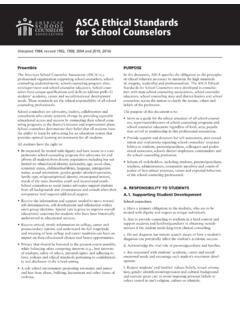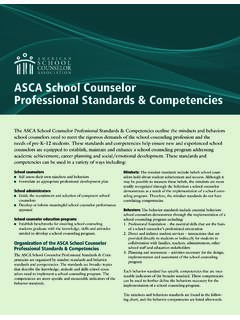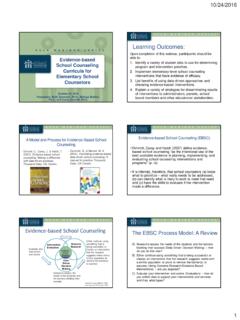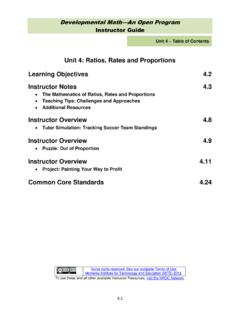Transcription of School Counselors Matter
1 School Counselors MatterSchool Counselors are just one part but an important part of a system that ensures students have excellent educational experiences. As part of a School support team, School Counselors provide critical social-emotional and academic supports. Through a comprehensive School counseling program that promotes success and achievement for all students, School Counselors can help set students on a path for postsecondary success. In particular, students of color and students from low-income families benefit from having more access to School Counselors .
2 For example, Black students are more likely than their White peers to identify their School counselor as the person who had the most influence on their thinking about postsecondary education. And research links the student-to- School -counselor ratios that meet the American School Counselor Association (ASCA) recommendation in high-poverty schools to better academic outcomes for students, such as improved attendance, fewer disciplinary incidents, and higher graduation put: There are not enough School Counselors in the The ASCA recommends that schools maintain a ratio of 250 students per School counselor, and that School Counselors spend at least 80 percent of their time working directly with or indirectly for students.
3 Across all schools, the average student-to- School -counselor ratio is 464 to 1. What s more, nearly 1 in 5 students about 8 million children do not have access to a counselor in their School at all, and nearly 3 million of those students do not even have access to other School support staff, such as School psychologists or social workers. Across high schools, the average student-to- School -counselor ratio is 311 students to 1. Only 1 in 5 high School students is enrolled in a School where there is a sufficient amount of School Counselors . This means there are 11 million high School students who are enrolled in a School without enough School often, School Counselors are not available to students of color and students from low-income families.
4 Students of color and students from low-income families have been overlooked and underserved for far too long. If anything, they deserve more access to School Counselors than their peers not the same, and certainly not less. And yet, the schools serving the most students of color or the most students from low-income families are shortchanged when it comes to School Counselors . Across all schools, 38 states are shortchanging either their students of color, students from low-income families, or both. Across high schools, a School counselor who serves predominantly students of color has to serve 34 more students every year than a School counselor who serves fewer students of color, and 27 states are shortchanging either their students of color, students from low-income families, or both.
5 FEBRUARY 38 states are shortchanging either their students of color or students from low-income families, or MapSOC MapFigure 2: Statewide High School Student-to- School -Counselor Ratio and Access for Students from Low-Income FamiliesSource: The Education Trust analysis of data from the 2015 16 Civil Rights Data Collection and the 2015 16 Common Core of access, too few counselorsUnequal access, enough counselorsBetter than equal access, too few counselorsBetter than equal access, enough counselorsFigure 1: Statewide High School Student-to- School -Counselor Ratio and Access for Students of ColorFEBRUARY These data paint a clear picture: In too many states, students especially students of color and students from low- income families do not have meaningful access to Counselors .
6 School Counselors can play a critical role in ensuring that students get opportunities to have safe, enriching experiences in and out of School , and in helping prepare students for postsecondary success all in ways that meet their individual needs. But it s difficult to do that meaningfully if School Counselors are responsible for supporting unmanageable numbers of students. What Advocates Can DoHere are some questions that education leaders and advocates should ask about how School Counselors are being incorporated into plans for improving opportunity and outcomes for all students especially for students of color and students from low-income families:If adequacy is a problem in your state or district: Is there a set requirement for the number of School Counselors per School or per number of students?
7 If so, are the requirements being met? If not, what is the strategy for ensuring that there is an adequate number of high-quality School Counselors in each School ? Are there particular districts across the state where the problem is most pronounced? If so, what can be done to support those districts to place more School Counselors in schools? What, if any, funding can be leveraged in the short term to address the most severe shortage areas? In the long term? How is the state or district ensuring there is a pipeline of School Counselors ? How does that strategy include partnerships with colleges and universities to appropriately train new School Counselors ?
8 If equity is a problem in your state or district: What are the policies or procedures for allocating School Counselors across districts or schools, and why is the distribution of School Counselors inequitable? What is the strategy for providing more School Counselors in high-need schools?FEBRUARY 2019 Produced by the Education Trust with Dorothyjean Cratty, Research


















